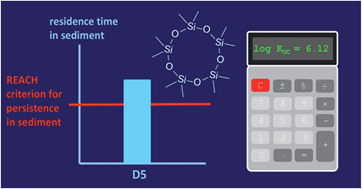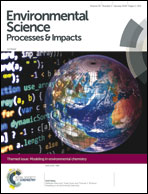A critical assessment of the environmental fate of linear and cyclic volatile methylsiloxanes using multimedia fugacity models
Abstract
We apply multimedia models to systematically evaluate the fate profile of cyclic volatile methyl siloxanes (VMS) D4, D5 and D6, and the linear VMS L4 and L5 using recently reported measurements of their partition ratios between organic carbon and water (KOC), their salting out constants (Ks), and their enthalpy of sorption to organic carbon (ΔHOC). Our assessment follows a multi-stage strategy where the environmental fate of the chemicals is explored in generic regional models with increasing fidelity to the real system and in a region-specific model. Modeled emissions of VMS to air remained in air and were degraded or advected out of the system with overall residence times ranging from 2.4 to 2.5 days, while emissions to water resulted in accumulation in sediment and longer residence times ranging from 29.5 to 1120 days. When emitted to water the modeled residence times of VMS in the sediment exceeded the REACH criterion for persistence in freshwater sediments. Reported KOC measurements for D5 differ by 1 log unit, which results in a 500-day difference in the overall residence times calculated in the generic regional modeling. In the specific-region modeling assessment for Adventfjorden, Svalbard in Norway, the different KOC measurements of D5 resulted in a 200-day difference in overall residence times. Model scenarios that examined combinations of previously published ΔHOC or enthalpy of phase change between octanol and water (ΔHOW) for D5 in combination with the range of the KOC measurements resulted in 1100-days difference in overall residence times. Our results demonstrate that residence times of VMS in aquatic systems are highly sensitive to their degree of sorption to organic carbon, and that residence times of VMS likely exceed several persistence criteria and therefore they cannot be considered as non-persistent.

- This article is part of the themed collection: Modeling in Environmental Chemistry


 Please wait while we load your content...
Please wait while we load your content...